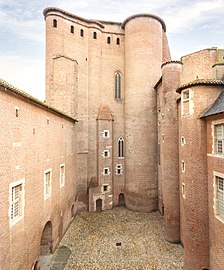You can help expand this article with text translated from the corresponding article in French. (November 2015) Click for important translation instructions.
|
| This article needs additional citations for verification. Please help improve this article by adding citations to reliable sources. Unsourced material may be challenged and removed. Find sources: "Musée Toulouse-Lautrec" – news · newspapers · books · scholar · JSTOR (August 2016) (Learn how and when to remove this message) |
The Musée Toulouse-Lautrec is an art museum in Albi, southern France, dedicated mainly to the work of the painter Henri de Toulouse-Lautrec who was born in Albi. The 13th-century building was originally the Bishop's Palace of Albi Cathedral, next to it. It is part of the UNESCO World Heritage Site that includes the cathedral.
The Bishop's Palace
The Bishop's Palace, or Palais épiscopal de la Berbi, was originally the residence of the bishop of Albi Cathedral, located next to the museum. It is included in the same UNESCO historical site as the cathedral. The Bishop's palace was begun before the Cathedral itself, by Bishop Durand de Beaucaire (bishop from 1228–1254). It was built with the features of a fortress during the period when the Catholic Church was at war with the a heretical sect called the Cathars, which originated in Albi.
Bishop de Combret, the next resident, further fortified his palace by connecting it to the Cathedral tower, twenty-five meters away. He added bastions and a machicoulis over the entrance, to drop heavy objects or boiling water on any attackers. The next owner, Bishop De Castanet, built a new wall around it and added Saint Catherine tower, which he linked to one of the towers of the cathedral.
Later Bishops modified the palace by adding a new residence, a chapel and a French-style garden. and filled the interior with mosaics and art. In 1905, when the Cathedral and its properties were officially nationalised, and the Palace was given to the city of Albi for use as a museum.
-
 Entrance of museum
Entrance of museum
-
 Palais de la Berbie, home of the Toulouse-Lautrec museum
Palais de la Berbie, home of the Toulouse-Lautrec museum
-
 Exterior of the Palais de la Berbie
Exterior of the Palais de la Berbie
-
 The garden of the Palais de la Berbie
The garden of the Palais de la Berbie
The Toulouse-Lautrec Museum
In 1922 the museum received an important collection of works by Henri de Toulouse-Lautrec, donated by his mother. The collection includes his last painting, Examination at the School of Medicine, from 1901.
The museum houses over a thousand works by and about Toulouse-Lautrec. It is based on a donation by Toulouse-Lautrec's mother after his death in 1901.
-
 Salon in the Rue des Moulins by Toulouse-Lautrec (1894)
Salon in the Rue des Moulins by Toulouse-Lautrec (1894)
-
 Examination at the Faculty of Medicine (1901), last painting by Toulouse-Lautrec
Examination at the Faculty of Medicine (1901), last painting by Toulouse-Lautrec
See also
References
- "Musee Toulouse-Lautrec". TripAdvisor. Retrieved 2 August 2016.
- Sire 2013, p. 27.
- Sire 2013, p. 27-28.
- ^ "Musée Toulouse-Lautrec | Albi, France Attractions". Lonely Planet. Retrieved 2020-11-15.
- "Toulouse-Lautrec et Tremolada, adjoint de Zidler au Moulin-Rouge, 1892". La collection Toulouse-Lautrec (in French). Musées Occitanie. Retrieved 28 May 2022.
Bibliography
- Sire, Marie-Anne (2013). Cathédrale Saint-Cécile d'Albi (in French). Centre des monuments nationaux, Éditions du patrimoine. ISBN 978-2-7577-0263-5.
External links
| Henri de Toulouse-Lautrec | |
|---|---|
| Paintings |
|
| Lithographs |
|
| Museums | |
| People | |
| Portrayals |
|
| Related | |
43°55′45″N 2°08′35″E / 43.92917°N 2.14306°E / 43.92917; 2.14306
This article related to an art display, art museum or gallery in France is a stub. You can help Misplaced Pages by expanding it. |